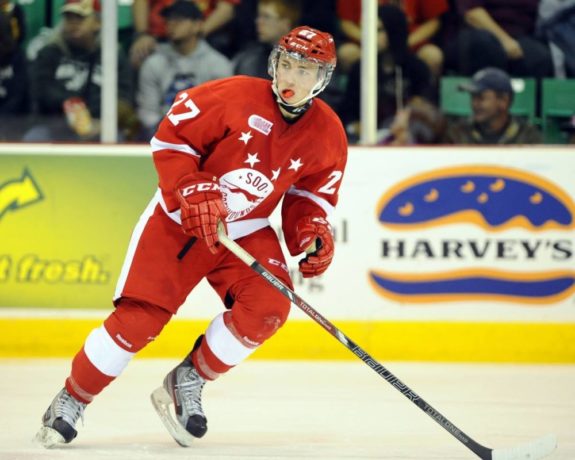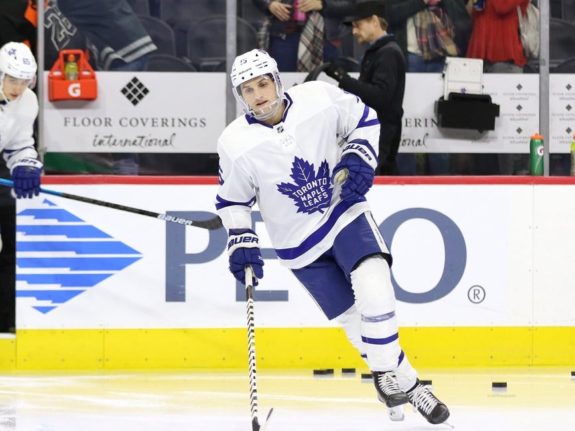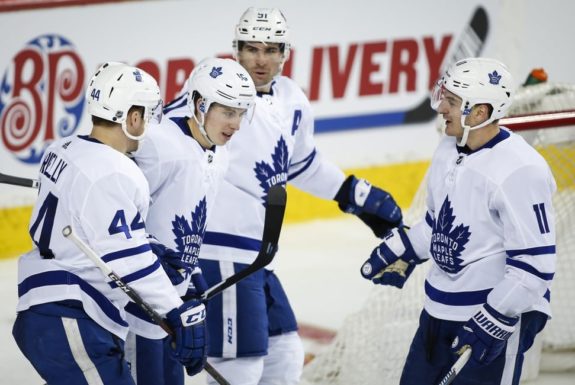In recent articles we’ve discussed the Toronto Maple Leafs’ acquisitions of both Nick Ritchie and Michael Bunting. Specifically, we’ve suggested that the organization’s hope is that one of them might become a better-than-adequate replacement for the departed Zach Hyman.
Related: Toronto Maple Leafs’ Alex Kerfoot: What Should Fans Know?
As Maple Leafs’ fans know well, Hyman’s departure to the Edmonton Oilers leaves a gap on the left wing of the top line of Auston Matthews and Mitch Marner. Because Hyman had a unique (and great) skill set as a hockey player, replacing him one-for-one would be nearly impossible. However, there are different aspects of his game that could be – if not replaced – replicated, albeit a bit differently.
Both Top-Six Left-Wing Positions Need to Be Filled
Perhaps Maple Leafs’ general manager Kyle Dubas has done well by bringing in Ritchie and Bunting. Maple Leafs’ fans can hope. The best case scenario is that both players slot beautifully into one of the respective left-wing roles on the top two lines. Even an eternal optimist has to believe that’s unlikely to work perfectly.

However, if it doesn’t happen, the Maple Leafs also have options for a left-wing spot on either of the team’s two top lines other than Ritchie and Bunting. One option that has received some discussion is Alex Kerfoot. In fact, during a visit to TSN’s Overdrive in late July Kyle Dubas hinted that might be on his mind when he stated: “In signing David Kampf, it allows us to be more flexible. You could potentially put Kerfoot onto the wing as needed.”
Could Alex Kerfoot Reasonably Replace Zach Hyman?
The question we’ll engage in this post is whether Kerfoot might be a reasonable option to replace Hyman on the left-wing? Here’s what we know about Kerfoot. First, he’s a much different type of player than Hyman. Although Kerfoot’s reasonably good defensively, he’s neither as big nor as physical as Hyman.
Related: Longest Stanley Cup Droughts
A simple comparison of hit totals from Hockey Reference shows that Kerfoot’s been credited with 153 hits in 278 games played. That’s an average of about 45 hits over 82 games. Hyman, on the other hand, has 480 hits in 345 games. That’s an average of about 114 hits over an 82-game schedule.
Could Kerfoot Produce the Offense that Hyman Produced?
We also know that Kerfoot doesn’t provide nearly the offense that Hyman produces; or, does he? A closer look at Kerfoot’s production during his career shows that he’s scored 51 goals and 85 assists (for 136 points) in 278 games. Hyman’s production has totalled 86 goals and 99 assists (for 185 points) in 345 games. Comparing the two players side-by-side over an 82-game schedule shows the following:
| Hyman | Kerfoot | |
| Goals per 82 games | 20 | 15 |
| Assists per 82 games | 24 | 25 |
| Points per 82 games | 44 | 40 |
The chart shows that Hyman has averaged five more goals and four more points per 82 games.
Kerfoot’s Production with the Colorado Avalanche
However, since he’s moved to Toronto from Colorado, Kerfoot has played in a much different role than he played with the Avalanche. And, that role might suggest why his scoring is down.

In Kerfoot’s 157 games with the Avalanche, he scored 34 goals and 51 assists (for 85 points). Over 82 games, that works out to 18 goals and 27 assists (for 45 points). In other words, Kerfoot’s production is actually a point higher over 82 games than Hyman’s.
Was It Kerfoot’s Avalanche Limemates?
Obviously, things are contextual; however, can we find what might be an explanation for the difference? If we look at Kerfoot’s most common line-mates for each team, we see the three most common forwards Kerfoot lined up with for the Avalanche were Tyson Jost (687 minutes), Colin Wilson (679 minutes), and J.T. Compher (628 minutes). With the Maple Leafs, his most common line-mates were Kasperi Kapanen (342 minutes), William Nylander (297 minutes), and Ilya Mikheyev (272 minutes). If we compare his line-mates’ 82-game scoring pace while playing alongside Kerfoot, we see the following.
| Avalanche | Maple Leafs | |
| Goals per 82 games | 15 | 22 |
| Assists per 82 games | 16 | 29 |
| Points per 82 games | 37 | 51 |
The chart shows that Kerfoot’s line-mates with the Maple Leafs were more productive with Kerfoot than his line-mates with the Avalanche. So, that doesn’t seem to account for his drop in production with the Maple Leafs.
Was the Difference Kerfoot’s Zone Starts?
Looking at Kerfoot’s zone starts offers Maple Leafs’ fans one possible reason why Kerfoot seems to be less productive with the Maple Leafs than he was with the Avalanche. Assuming that starting in one’s own defensive zone is a disadvantage, Kerfoot was placed into more difficult assignments by the coaching staff.
Related: Maple Leafs Must Consider All Factors Before Acquiring P.K. Subban
Specifically, with Colorado, Kerfoot started in the offensive zone almost two-thirds (62.3 percent) of the time and in the defensive zone just over one-third of the time (37.7 percent). With the Maple Leafs, 51.5% of his zone starts were in the offensive zone and 48.5% were in the defensive zone.
Was the Difference Kerfoot’s Power-Play Usage?
Looking at Kerfoot’s power-play usage, with the Avalanche he averaged 2:30 per game on the power play. With the Maple Leafs, his power-play time dropped to under a minute per game. Comparing Kerfoot’s power-play and five-on-five production shows the following:
Kerfoot’s Power-Play Production per 82-game pace
| Colorado | 5 goals | 13 assists | 18 points |
| Toronto | 1 goal | 3 assists | 4 points |
Kerfoot’s Five-on-Five Production per 82-game pace
| Colorado | 12 goals | 13 assists | 25 points |
| Toronto | 9 goals | 20 assists | 29 points |
As the chart shows, Kerfoot’s five-on-five production has actually been higher with the Maple Leafs than it was with the Avalanche. Comparing his play with both teams, the biggest difference in his overall production is that he played just over 1:30 more minutes of power-play time with the Avalanche.
Kerfoot Is Different than Hyman, But Perhaps as Effective
Although it would be silly to say that Kerfoot’s the same type of player Hyman is, it would also ignore the evidence to suggest that he couldn’t become as productive offensively. It would just be in a different way.

Specifically, if Kerfoot were given more offensive opportunities and more power-play minutes, there’s a good chance his overall production could match and possibly even surpass Hyman’s.
By the way, Kerfoot’s playoff performance against the Montreal Canadiens also suggests how important he can be during the postseason. Given the total shutdown of the Maple Leafs’ first-line by the Canadiens, that Kerfoot scored a goal and five assists (for six points) is not insignificant.
Related: Was There a Chance Sidney Crosby Could Have Played in Toronto?
Such playoff production certainly doesn’t hurt an argument in favor of his being given more ice time with the top-six units.
[Note: I want to thank long-time Maple Leafs’ fan Stan Smith for collaborating with me on this post. Stan’s Facebook profile can be found here.]